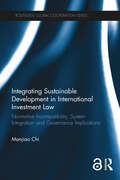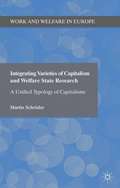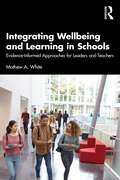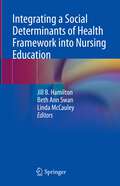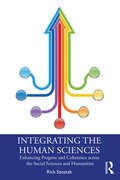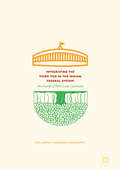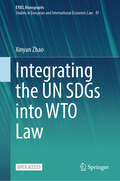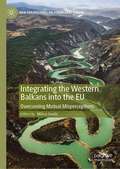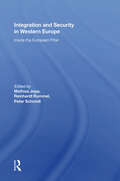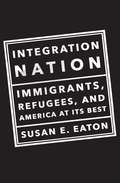- Table View
- List View
Integrating Sustainable Development in International Investment Law: Normative Incompatibility, System Integration and Governance Implications (ISSN)
by Manjiao ChiThe current international investment law system is insufficiently compatible with sustainable development. To better address sustainable development concerns associated with transnational investment activities, international investment agreements should be made more compatible with sustainable development.Integrating Sustainable Development in International Investment Lawpresents an important systematic study of the issue of sustainable development in the international investment law system, using conceptual, normative and governance perspectives to explore the challenges and possible solutions for making international investment law more compatible with sustainable development. Chi suggests that to effectively address the sustainable development concerns associated with transnational investment activities, the international investment agreements system should be reformed. Such reform should feature redesigning the provisions of the agreements, improving the structure of international investment agreements, strengthening the function of soft law, engaging non-state actors and enhancing the dispute settlement mechanism.The book is primarily aimed at national and international treaty and policy-makers, lawyers and scholars. It is also suitable for graduate students studying international law and policy-making.The Open Access version of this book, available at http://www.taylorfrancis.com, has been made available under a Creative Commons Attribution-Non Commercial-No Derivatives (CC-BY) 4.0 license.
Integrating Sustainable Development in International Investment Law: Normative Incompatibility, System Integration and Governance Implications (Routledge Global Cooperation Series)
by Manjiao ChiThe current international investment law system is insufficiently compatible with sustainable development. To better address sustainable development concerns associated with transnational investment activities, international investment agreements should be made more compatible with sustainable development. Integrating Sustainable Development in International Investment Law presents an important systematic study of the issue of sustainable development in the international investment law system, using conceptual, normative and governance perspectives to explore the challenges and possible solutions for making international investment law more compatible with sustainable development. Chi suggests that to effectively address the sustainable development concerns associated with transnational investment activities, the international investment agreements system should be reformed. Such reform should feature redesigning the provisions of the agreements, improving the structure of international investment agreements, strengthening the function of soft law, engaging non-state actors and enhancing the dispute settlement mechanism. The book is primarily aimed at national and international treaty and policy-makers, lawyers and scholars. It is also suitable for graduate students studying international law and policy-making.
Integrating Varieties of Capitalism and Welfare State Research: A Unified Typology of Capitalisms (Work and Welfare in Europe)
by Martin SchröderThis book combines the two most important typologies of capitalist diversity; Esping-Andersen's welfare regime typology and Hall and Soskice's 'Varieties of Capitalism' typology, into a unified typology of capitalist diversity. The author shows empirically that certain welfare states bundle together with certain production systems.
Integrating Wellbeing and Learning in Schools: Evidence-Informed Approaches for Leaders and Teachers
by Mathew A. WhiteIntegrating Wellbeing and Learning in Schools argues that wellbeing research can help address the hurdles that school leaders face by incorporating a more interdisciplinary approach from contemporary governance, leadership, and management. The COVID-19 pandemic has accelerated the problem of the wellbeing learning poverty cycle in schools worldwide. This book makes the case for a new and comprehensive integration of wellbeing in school governance, leadership, and teaching theories across disciplines during the recovery phase of the COVID-19 pandemic. It argues for operationalising wellbeing goals and integrating these into evidence-informed professional practice. Drawing on evidence-informed wellbeing education, teaching theories, and original research, the book comprehensively considers the integration of wellbeing education from the perspectives of school governance and leadership, middle management, teachers, student leadership, and the students themselves. This book will be of interest to postgraduate students of education leadership, educators, and school leaders.
Integrating a Social Determinants of Health Framework into Nursing Education
by Beth Ann Swan Jill B. Hamilton Linda McCauleyThe purpose of this ground-breaking Textbook is to describe and illustrate, with pedagogical features, the process by which social determinants of health (SDOH) has been integrated throughout all courses in the Nell Hodgson Woodruff School of Nursing. Specifically, the authors describe initial steps to develop a comprehensive SDOH model for nursing education, followed by rigorously designed faculty educational materials, exemplars of SDOH instructional materials, and evaluation of this process from faculty and students. It describes a comprehensive framework that guides the development, implementation, and evaluation of SDOH across the pre-licensure and post-licensure curriculum and illustrate the process integrating SDOH throughout all aspects of didactic, simulation, and clinical education. Among the subjects addressed, the history of nursing and SDOH and the value of SDOH content in nursing courses to alleviate health disparities are described and mandates to integrate SDOH content into nursing curriculum by the leading nursing organizations are summarized. The authors also include a review of existing SDOH frameworks used in public health and medicine and present a comprehensive SDOH model for nursing education. A SDOH educational course content for faculty is detailed (Social Determinants of Health 101) and exemplars from faculty and students are provided along with an evaluation after the first year. The authors conclude with a discussion from faculty leadership; what they learned and their suggestions to other nursing programs. Although there are books published, no books exist on this topic for nursing education and practicing nurses, yet SDOH is foundational to nursing curriculum and practice. The leading nursing organizations are all mandating that SDOH be integrated into nursing courses. Hence this textbook will be a key resource for Schools of Nursing in the US and globally. The intended audience of this book are leaders and faculty of nursing education programs, national professional nursing organizations, practicing nurses at hospitals and health systems, community and public health agencies, and ambulatory care.
Integrating the Human Sciences: Enhancing Progress and Coherence across the Social Sciences and Humanities
by Rick SzostakWhat if we recognized that the human sciences collectively investigate a few dozen key phenomena that interact with each other? Can we imagine a human science that would seek to stitch its understandings of this system of phenomena into a coherent whole? If so, what would that look like? This book argues that we are unlikely to develop one unified "theory of everything." Our collective understanding must then be a "map" of the myriad relationships within this large – but finite and manageable – system, coupled with detailed understandings of each causal link and of important subsystems. The book outlines such a map and shows that the pursuit of coherence – and a more successful human science enterprise – requires integration, recognizing the strengths and weaknesses of different methods and theory types, and the pursuit of terminological and presentational clarity. It explores how these inter-connected goals can be achieved in research, teaching, library classification, public policy, and university administration. These suggestions are congruent with, and yet enhance, other projects for reform of the human sciences. This volume is aimed at any scholar or student who seeks to comprehend how what they study fits within a broader understanding.
Integrating the Third Tier in the Indian Federal System
by Atul Sarma Debabani ChakravartyThis book discusses the evolution of the third tier of the Indian federal system, with a focus on rural local governance (commonly known as Panchayati Raj) against the backdrop of important theoretical and empirical literature on the relevance and effectiveness of service delivery in the decentralized system. It evaluates the quintessence of the functioning of the Panchayati Raj in the past two decades of its existence. This pioneering book also discusses the treatment of the third-tier government in the inter-governmental fiscal transfer framework and the delineation of the unique institution of local self-government in the Northeastern Indian States. In the light of the loosely evolved fiscal relations between three levels of government, it has been observed that local self-governments in the bottom tier have not been truly empowered yet. The book argues in favor of integrating the third-tier government into the Indian federal system and suggests how this could be achieved.
Integrating the UN SDGs into WTO Law (European Yearbook of International Economic Law #41)
by Xinyan ZhaoThis is an open access book. Sustainable development is so important that humanity must do its utmost to achieve these goals for the well-being of the present and future generations. WTO members have started to reform WTO rules since the WTO’s Buenos Aires Ministerial Conference in 2017. The book describes a possible bright future for readers: WTO members can integrate the UN SDGs into WTO law (i.e., create sustainable trade rules) by establishing a sustainable development club and constitutionalising the WTO.
Integrating the US Military: Race, Gender, and Sexual Orientation since World War II
by Douglas Walter Bristol, Jr., and Heather Marie SturHow have the US Armed Forces been transformed by integration?One of the great ironies of American history since World War II is that the military—typically a conservative institution—has often been at the forefront of civil rights. In the 1940s, the 1970s, and the early 2000s, military integration and promotion policies were in many ways more progressive than similar efforts in the civilian world. Today, the military is one of the best ways for people from marginalized groups to succeed based solely on job performance.Integrating the US Military traces the experiences of African Americans, Japanese Americans, women, and gay men and lesbians in the armed forces since World War II. By examining controversies from racial integration to the dismantling of "Don’t Ask, Don’t Tell" to the recent repeal of the ban on women in combat, these essays show that the military is an important institution in which social change is confirmed and, occasionally, accelerated. Remarkably, the challenges launched against the racial, gender, and sexual status quo in the postwar years have also broadly transformed overarching ideas about power, citizenship, and America’s role in the world.The first comparative study of legally marginalized groups within the armed services, Integrating the US Military is a unique look at the history of military integration in theory and in practice. The book underscores the complicated struggle that accompanied integration and sheds new light on a broad range of comparable issues that affect civilian society, including affirmative action, marriage laws, and sexual harassment.
Integrating the Western Balkans into the EU: Overcoming Mutual Misperceptions (New Perspectives on South-East Europe)
by Milica UvalićAmong the main stumbling blocks of European Union-Western Balkan integration are the differences in perceptions on both sides. Today, the gap between what the Western Balkan politicians and citizens think about the European Union and what the politicians and citizens in the EU member states think about the Western Balkans is probably wider than ever. This volume offers fresh insights about these misperceptions and how to possibly bridge the gap. It examines perceptions about the region’s “European perspectives” both on the side of the six Western Balkan countries - Albania, Bosnia and Herzegovina, Kosovo, Montenegro, North Macedonia and Serbia – and the key European Union member states (Italy, Germany, Croatia), international donors, USA. An analysis of the diverse views regarding the prospects of EU – Western Balkan integration is today highly relevant, in view of the current uncertainties regarding European Union’s enlargement policy, particularly after the attack of Russia on Ukraine and candidate status granted to Ukraine and Moldova.
Integration And Security In Western Europe: Inside The European Pillar
by Mathias JoppThe contributors to this volume discuss how a West European security union would fit into the trans Atlantic and trans-European settings. Representatives from each of the West European NATO and EC member countries contribute their national views on the subject while representatives of major institutions (European Political Cooperation, the European Parliament, NATO and the West European Union) offer their international perspectives.
Integration Nation: Immigrants, Refugees, and America at Its Best
by Susan E. Eaton&“Eaton has done invaluable work in documenting the revitalization of communities across the U.S. by immigrants and refugees&” (David Bacon, author of Illegal People). In recent years, politicians in a handful of local communities and states have passed laws and regulations designed to make it easier to deport unauthorized immigrants or to make their lives so unpleasant that they&’d just leave. The media&’s unrelenting focus on these ultimately self-defeating measures created the false impression that these politicians speak for most of America. They don&’t. Integration Nation takes readers on a spirited and compelling cross-country journey, introducing us to the people challenging America&’s xenophobic impulses by welcoming immigrants and collaborating with the foreign-born as they become integral members of their new communities. In Utah, we meet educators who connect newly arrived Spanish-speaking students and US-born English-speaking students, who share classrooms and learn in two languages. In North Carolina, we visit the nation&’s fastest-growing community-development credit union, serving immigrants and US-born depositors and helping to lower borrowing thresholds and crime rates alike. Giving a voice to people who choose integration over exclusion, who opt for open-heartedness instead of fear, Integration Nation is a desperately needed road map for a nation still finding its way beyond anti-immigrant hysteria to higher ground. &“This useful book provides models for civic organizations that want to tackle immigration challenges, and it paints a vivid picture of some real successes.&” —Publishers Weekly &“Presents in discrete essays an array of compelling and persuasive regional efforts across the country . . . From Indiana to Georgia to Maine, these intelligent model programs should inspire others.&” —Kirkus Reviews
Integration Through Law: ASEAN Economic Cooperation and Integration
by Chia, Siow Yue and Plummer, Michael G. Siow Yue Chia Michael G. PlummerASEAN economic cooperation and integration have come a long way since the organisation's early days, when cooperation was more political and diplomatic than economic in nature. ASEAN now constitutes the most ambitious organisation of regional cooperation and integration in the developing world. This book investigates the economics of various ASEAN and ASEAN-centric economic integration initiatives, focusing in particular on the ASEAN Economic Community (AEC). In addition to assessing the potential effects of the AEC on the economies of the ten ASEAN member states via changes in trade, foreign direct investment and economic structure, this book underscores the implementation challenges ASEAN faces as it completes the AEC project. It also considers the AEC in the context of the Regional Comprehensive Economic Partnership (RCEP). This comprehensive study is written for academic researchers and students, as well as for policy makers in ASEAN as they chart the future policy path of the region.
Integration Through Law: ASEAN as an Actor in International Fora
by Jürgen Rüland Nguitragool, Paruedee and Rüland, Jürgen Paruedee NguitragoolASEAN as an Actor in International Fora addresses a blind spot in ASEAN research and in comparative regionalism studies by assessing why, how, when and to what extent ASEAN member governments achieve a collective presence in global fora. Written for academic researchers and practitioners working in areas such as international relations, political science and international law, it examines ASEAN's negotiating behavior with a novel four-point cohesion typology. The authors argue that ASEAN's 'cognitive prior' and its repository of cooperation norms have affected ASEAN's negotiation capacities, formats, strategies and cohesion in international fora. Using two case studies - one on ASEAN's cohesion in the WTO agricultural negotiations and one on UN negotiations on forced labor in Myanmar - they examine ASEAN's collective actions at different stages of negotiation, in different issue areas and in different negotiating fora. The book concludes by providing recommendations for strengthening ASEAN's international negotiation capacities.
Integration Through Law: Comparative Regional Integration
by Carlos Closa Lorenzo CasiniComparative Regional Integration: Governance and Legal Models is a groundbreaking comparative study on regional or supranational integration through international and regional organizations. It provides the first comprehensive and empirically based analysis of governance systems by drawing on an original sample of 87 regional and international organizations. The authors explain how and why different organizations select specific governance processes and institutional choices, and outline which legal instruments – regulatory, organizational or procedural – are adopted to achieve integration. They reveal how different objectives influence institutional design and the integration model, for example a free trade area could insist on supremacy and refrain from adopting instruments for indirect rule, while a political union would rather engage with all available techniques. This ambitious work merges different backgrounds and disciplines to provide researchers and practitioners with a unique toolbox of institutional processes and legal mechanisms, and a classification of different models of regional and international integration.
Integration Through Law: From Community to Compliance?
by Simon ChestermanIn the past decade, the Association of Southeast Asian Nations (ASEAN) has transformed from a periodic meeting of ministers to setting ambitious goals of becoming a Community by 2015. ASEAN is now the most important regional organisation in the history of the continent of Asia. An important tension in this transformation is the question of whether the 'ASEAN way' - defined by consultation and consensus, rather than enforceable obligations - is consistent with the establishment of a community governed by law. This book examines the growing interest in following through on international commitments, in particular monitoring implementation and compliance. Key barriers remain, in particular the lack of resources and ongoing resistance to accepting binding obligations. It remains to be seen whether these trends herald a more measured approach to decision-making in ASEAN. Written for practitioners and researchers alike, this important book provides the first systematic survey of monitoring within ASEAN.
Integration Through Law: From Treaty-making to Treaty-breaking
by Kuijper, Pieter Jan and Mathis, James H. and Morris-Sharma, Natalie Y. Pieter Jan Kuijper James H. Mathis Morris-Sharma, Natalie Y.From Treaty-Making to Treaty-Breaking is the first high-level analysis of ASEAN's external trade agreements with non-ASEAN states. It clearly sets out the intended, and unintended, consequences of ASEAN's prevailing method of treaty making, with suggested guidelines for the future. The book begins by asking whether ASEAN trade agreements follow worldwide trends in the substantive content of such agreements. It raises questions such as: to what extent is it possible to continue concluding trade agreements through individual member states?; what are the legal consequences - from negotiation and conclusion (treaty-making) through to possible breach of the agreements (treaty-breaking)?; should ASEAN resort to mixed treaty-making? This study does not seek to give a definitive answer to these questions, rather it opens up the topic to readers by suggesting different possible models for ASEAN trade agreements. This thought-provoking book will appeal to anyone interested in trade negotiations and trade agreements, particularly in Asia.
Integration Through Law: Promoting Compliance
by Beckman, Robert and Bernard, Leonardo and Phan, Hao Duy and Hsien-Li, Tan and Yusran, Ranyta Robert Beckman Leonardo Bernard Hao Duy Phan Tan Hsien-Li Ranyta YusranThe reputation and achievement of the ASEAN Community hinges on compliance. This seminal book discusses whether ASEAN's faith in dispute settlement and monitoring mechanisms as a means to better compliance is justified and delves into the extent to which they can facilitate ASEAN Community building. It provides the first comprehensive and systematic analysis of ASEAN's compliance with its instruments, and enables readers to see ASEAN as an organisation increasingly based on law and institutions. Readers will also learn how ASEAN balances a thin line between law and institutions on the one hand and diplomacy and realism on the other. Scholars of adjudicatory mechanisms will find this book a fascinating addition to the literature available, and it will serve as a 'go-to' reference for ASEAN state agencies. The book will also interest academics and practitioners working on comparative and cross-disciplinary studies of dispute settlement, monitoring mechanisms, compliance, and international and regional organisations.
Integration Through Law: Sustainable Goals?
by Robinson Kheng-Lian Koh Nicholas A. Lin-Heng LyeWhile the environmental performance of most ASEAN member states is above the world average, ASEAN nations will continue to face growing environmental challenges due to pressures exerted on them such as population growth, urbanization and industrialization. The authors of this book look at how the member states of ASEAN employ law as a means of regional integration within the context of environmental conservation. While the goal of new laws is to implement sustainable development, it continues to be an ongoing adaptive process, since clear and immediate answers to environmental challenges are rarely available. Readers of this book will gain a clear idea of the evolving cooperation for sustainability within ASEAN at regional and global levels, and the areas of focus for the future. The book will be of interest to policy and decision makers, as well as environmental organizations and academics in the field.
Integration Through Law: The ASEAN Economic Community
by Jacques PelkmansThe Association of Southeast Asian Nations (ASEAN) has experienced rapid economic growth for many years. Although the population of ASEAN is larger than the EU-28, the emerging ASEAN market, called the ASEAN Economic Community (AEC), is still little understood by policy makers in many parts of the world, by business professionals and students, as well as by scholars in economics, business, politics and economic law. This book provides, for the first time, a rigorous analytical approach of the new AEC and its intricacies. It sets out its ambition, scrutinises its economic integration logic and detects its deficits. Besides a detailed analysis of the AEC Roadmap, the book also elaborates on its achievements. Several strategic economic options for the AEC, in particular as an instrument to accelerate the economic development of the region, are explored.
Integration Through Law: The Foundation of the ASEAN Economic Community
by Stefano Inama Sim Edmund W.ASEAN has undertaken the complex task of creating a single economic entity for Southeast Asia by 2015 in the form of the ASEAN Economic Community (AEC), but without regulators or supranational institutions, its implementation has been an inconsistent process. Through comparisons with the EU and NAFTA, this book illustrates the shortcomings of the current system, enabling readers to understand both the potential of regional economic development in ASEAN and its foundational and institutional deficiencies. The authors' analysis of trade in goods and services, investment, and dispute resolution in the AEC indicates that without strong regional institutions, strong dispute resolution or a set of norms, full and effective implementation of the AEC is unlikely to result. The book offers clear solutions for the ASEAN institutions to help the AEC reach its full potential. Written by two leading practitioners, this insightful book will interest policymakers, students and researchers.
Integration Through Law: The Internal Effects of ASEAN External Relations
by Venzke, Ingo and Thio, Li-ann Ingo Venzke Li-Ann ThioStarting with a typology of ASEAN external agreements, the authors go on to provide an original reading of plurilateral agreements as 'joint' agreements. The book then offers both a clarification of the effects - direct or indirect - of external agreements within the legal orders of ASEAN Member States, and an explanation of the effects of external agreements within the legal regime of ASEAN. The authors conclude with a discussion of the role of ASEAN centrality and the role of the secretariat in shaping it.
Integration Through Law: The Role of the Public Bureaucracy in Policy Implementation in Five ASEAN Countries
by Quah, Jon S. T.This pioneering book addresses an important gap in the literature by comparing the role of the public bureaucracies in policy implementation in Indonesia, Malaysia, the Philippines, Singapore and Vietnam. It highlights the importance of the policy context, especially the commitment of the government in allocating the necessary resources and the support of the implementers, as well as the public bureaucracy's effectiveness, as the critical factors responsible for effective policy implementation. The comparative analysis shows that the public bureaucracies in Singapore and Malaysia are more effective in policy implementation than their counterparts in Indonesia, the Philippines and Vietnam because of their favourable policy contexts and higher level of organizational effectiveness. The focus on policy context and the public bureaucracy's role in the policy-making process and its implementation of two ASEAN policies will be of interest to policymakers, civil servants, scholars and students concerned with enhancing policy implementation in the ASEAN countries.
Integration Through Law: Towards a Rules-Based Community
by Jean-Claude Piris Piris, Jean-Claude and Woon, Walter Walter WoonIn 2007, ASEAN adopted the ASEAN Charter, which stated its ambition to become a 'rules-based' community respecting the rule of law. In order to fulfil this objective, it is vital that the necessary legal infrastructure has effective legal support. This book helps readers to understand the need for and role of such a legal service. To begin with, it explores the way ASEAN and its various institutions have evolved. The current situation with respect to the making of rules and settlement of disputes is then analysed, drawing not only on published primary and secondary materials, but also on the experience of diplomats, officials and legal officers. Finally, the authors draw on their practical experiences, as former attorney-general of an ASEAN member state and former head of the European Council legal service, to make recommendations on how an ASEAN Legal Service might be organised.
Integration and Clustering for Sustainable Economic Growth (Contributions to Economics)
by Elena G. Popkova Valentina E. Sukhova Aleksey F. Rogachev Yulia G. Tyurina Olga A. Boris Valentina N. ParakhinaThis book describes the importance of integration and clustering in creating sustainable economic growth. Modern economic conditions demonstrate the need for governmental stimulation of cluster initiatives in entrepreneurship, and make it necessary to study the experience of developed countries in the sphere of stimulation of cluster initiatives in entrepreneurship, and to offer recommendations for improving the system of state stimulation of these initiatives. The authors conclude that at present, innovational economy is an economic system that functions on the basis of business networks, as this model offers innovational cooperation between specialists from various scientific and technical spheres, between organizations of various sizes (large, medium, and small), and between groups of various types of companies. Cluster strategy in modern global practice is one of the most important tools of public policy for increasing the competitiveness of national economies. This means that the most competitive spheres develop on the basis of the cluster principle, and support for cluster building increases a country’s economic competitiveness.
